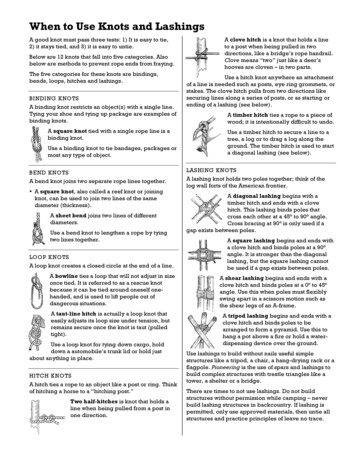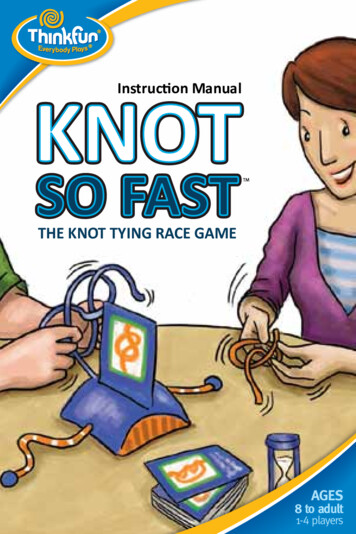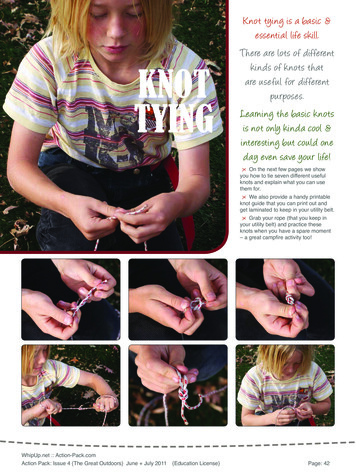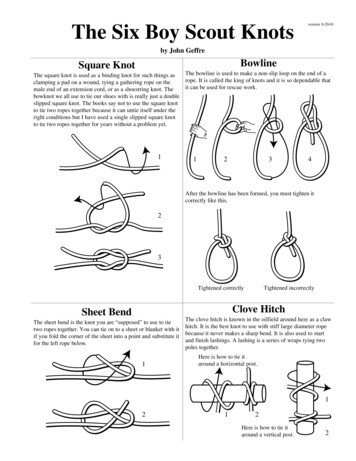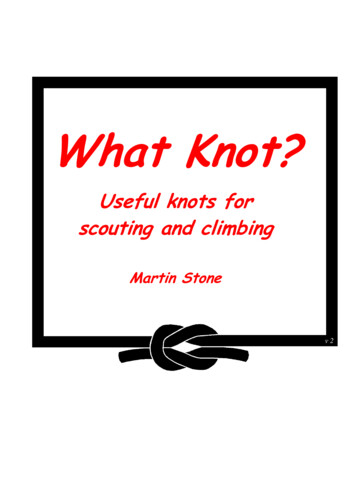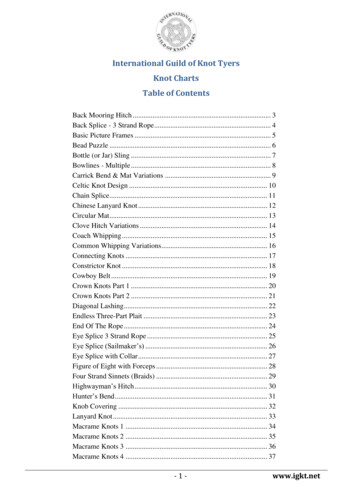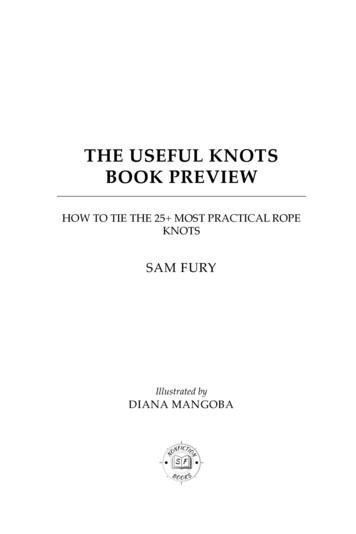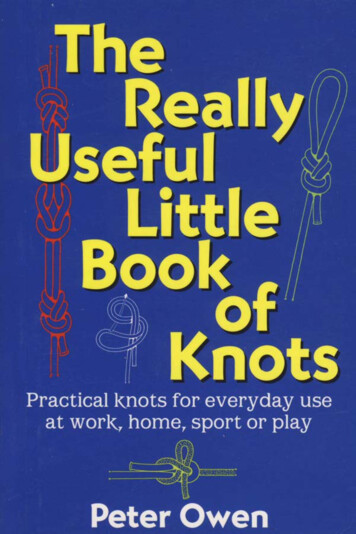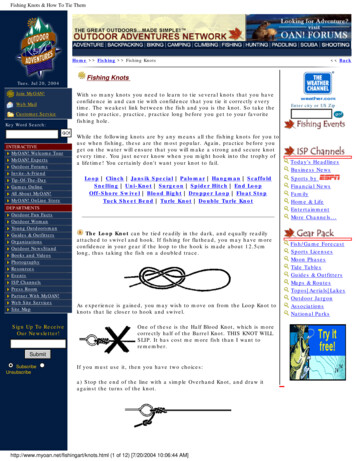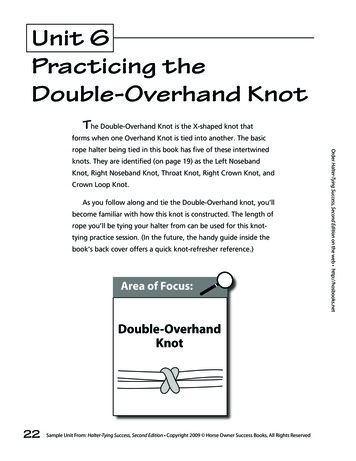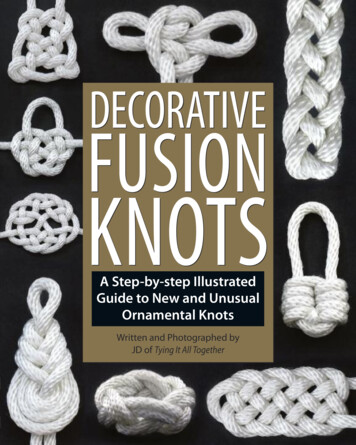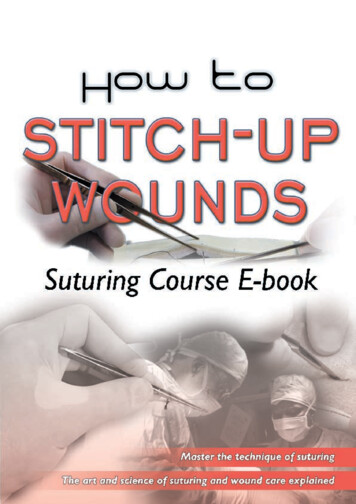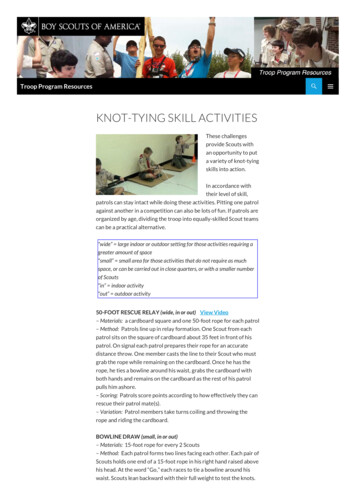
Transcription
Troop Program Resources KNOT-TYING SKILL ACTIVITIESThese challengesprovide Scouts withan opportunity to puta variety of knot-tyingskills into action.In accordance withtheir level of skill,patrols can stay intact while doing these activities. Pitting one patrolagainst another in a competition can also be lots of fun. If patrols areorganized by age, dividing the troop into equally-skilled Scout teamscan be a practical alternative.“wide” large indoor or outdoor setting for those activities requiring agreater amount of space“small” small area for those activities that do not require as muchspace, or can be carried out in close quarters, or with a smaller numberof Scouts“in” indoor activity“out” outdoor activity50-FOOT RESCUE RELAY (wide, in or out) View Video– Materials: a cardboard square and one 50-foot rope for each patrol– Method: Patrols line up in relay formation. One Scout from eachpatrol sits on the square of cardboard about 35 feet in front of hispatrol. On signal each patrol prepares their rope for an accuratedistance throw. One member casts the line to their Scout who mustgrab the rope while remaining on the cardboard. Once he has therope, he ties a bowline around his waist, grabs the cardboard withboth hands and remains on the cardboard as the rest of his patrolpulls him ashore.– Scoring: Patrols score points according to how effectively they canrescue their patrol mate(s).– Variation: Patrol members take turns coiling and throwing therope and riding the cardboard.BOWLINE DRAW (small, in or out)– Materials: 15-foot rope for every 2 Scouts– Method: Each patrol forms two lines facing each other. Each pair ofScouts holds one end of a 15-foot rope in his right hand raised abovehis head. At the word “Go,” each races to tie a bowline around hiswaist. Scouts lean backward with their full weight to test the knots.
– Scoring: The first patrol to have all bowlines tied correctly and allScouts leaning backwards wins.BOWLINE SHEET BEND DRAW (small, in or out) View Video– Materials: 6-foot rope or braided nylon cord for each Scout– Method: Each patrol forms two lines facing each other. Each Scoutholds his rope in his right hand raised above his head. At the word“Go,” each races to tie a Bowline around his waist, then join theropes together with a Sheet Bend. Scouts lean backward with theirfull weight to test the knots.– Scoring: The first patrol to have all knots tied correctly and allScouts leaning backwards, with their Sheet Bends next to each otherin a straight line, wins.CANNIBAL RESCUE (wide, in or out)– Materials: 30 to 50-foot x 1/4 to 3/8-inch manila or braided nylonfor each patrol– Method: The patrols line up in relay formation behind a line. Asecond line is marked out 20 to 30 feet away, parallel to the first.The first Scout in each patrol is given a rope, and the following storyis related: “You are fleeing from cannibals and have reached thebank of a wide river. Only one Scout in each patrol can swim. Therest of the patrol must be “pulled” across with the help of a rope.” Onsignal, the first Scout in each patrol “swims” (runs) with the rope tothe other “shore” (second line) and throws one end of the rope backacross the “river” to the second Scout in line. The second Scout ties abowline around his waist and is figuratively pulled across to theother shore by the first Scout. Then the second Scout unties therope, throws it to the next Scout in line, and so on. This continuesuntil the whole patrol is safely across. Note: Scouts must wait untilthe rope is thrown far and accurately enough for them to grab it,without entering the “river”.– Scoring: The first patrol to get all of its members across the riverwith correctly tied bowlines wins.EIGHT KNOT CONTEST (wide, in or out)– Materials: for each patrol three 6-foot x 1/4-inch manila ropes (orbraided nylon cords), one 12-foot x 1/4-inch manila rope (or braidednylon cord), one log 2-foot long and 3 to 6 inches in diameter, twotrees or upright poles 12 to 16 feet apart– Method: Lay all the materials on the ground between the trees orupright poles. On signal, with one 6-foot rope, each patrol ties an endto a tree or pole with two half hitches / joins the other end to asecond 6-foot rope with a square knot / ties one end of the third 6foot rope to one end of the log with a timber hitch / forms a loop onthe other end of the third 6-foot rope with a bowline / uses thebowline’s loop as the bend to tie a sheet bend to the free end of thesecond 6-foot rope. Each patrol will also tie one end of the 12-footrope to the other tree or pole with a taut-line hitch / and the otherend to the log with a clove hitch. Finally they will raise the logparallel to the ground by shortening the 12-foot rope with asheepshank.– Scoring: The first patrol to suspend the log parallel to the groundwith all knots correctly tied wins.HOLD-EM DEMONSTRATION (small, in or out)
– Materials: 20-foot rope for each patrol– Method: On signal, the first Scout takes hold of one end of the ropeand makes one roundturn around a tree or immovable pole. Leavingenough rope to easily tie two half hitches, he holds onto the runningend with one hand. While the first Scout maintains a grip on his endof the rope, a second Scout pulls on the other end of the rope.Relying on the friction created by the roundturn and withstandingthe pull on the rope created by the second Scout, the first Scout nowcan secure the line with two half hitches snugged up against the treeor pole.– Scoring: None. Each Scout takes a turn tying a roundturn with twohalf hitches in this manner.HORIZONTAL HALF HITCHING RACE (small, in or out) ViewVideo– Materials: horizontal pole(s) set up waist-high with pairs of 3-footlengths of braided nylon or paracord cords, attached and hangingdown (enough for each participant to have 2 cords right next to eachother, set apart from other pairs of cords leaving enough space foreach Scout to apply the half hitches without interfering with theScout next to him)– Method: On signal, Scouts race to tie a series of four half hitcheswith with each cord, one cord proceeding from the left, and theother proceeding from the right. When they have completed alleight half hitches, they yell out, “done!” (Switch off so all Scouts get aturn.)– Variation: Tie the two pairs of cords about a foot from the ends of aScout stave. Scouts pair up and sitting down either next to or acrossfrom one another, and race to tie the half hitches with the stavebalanced on their laps.– Scoring: The first Scout to correctly complete all eight wins thatround.HOT ISOTOPE TRANSPORT (wide, out) View Video– Materials: For each patrol, one can filled to a mark 1/2-inch fromthe top with water, in the middle of a well-defined circle 20 feet indiameter, six 15 foot cords, elastic circle.– Method: The patrol assembles a “Hot Isotope Transporter” byattaching the cords to the elastic circle with two half hitches. Theythen line up around the can staying outside the circle at all times, andunder the direction of their patrol leader, the Scouts pull the cordsto stretch the elastic circle. The object is to bring the expandedelastic circle down over the can, then relax the elastic circle to fittightly over the can. They then lift and deposit the can upright to apoint outside the circle, without spilling any water.– Scoring: Each patrol scores a point for transporting the can withoutspilling any water. All knots correctly tied earn an additional point.The fastest patrol earns an additional point.Back to top of pageKNOT HOOP RELAY (small, in or out)– Materials: 6-foot rope for each patrol– Method: On signal, the first Scout ties the rope into a hoop with asheet bend and passes it over his head and down his body. He stepsout of the hoop, unties the knot and passes the rope to the nextScout who repeats the method and so on down the line. A judge for
each patrol will observe the knots.– Scoring: Points are given for each correctly tied sheet bend, andextra points to the patrol that finishes the quickest. If there aredifferent numbers of Scouts in the patrols, announce a specificnumber of knots to be tied, requiring some patrol members to gomore than once.KNOT MASTER TUG OF WAR (wide, in or out)– Materials: for every two teams, one 4-foot and two 10-foot x 1/4inch ropes, whipped on both ends, a playing area 40-feet wide with amarked center line– Method: The object of this game is to pull the 4-foot rope awayfrom the other other team. The contest can be played betweenpatrol teams or between chosen troop teams. In the center of theplaying area is the 4-foot rope. Two teams, each with a 10-foot rope,assemble facing each other on either side, twenty feet away. Thegame leader will call out the name of a joining knot, either: sheetbend, carrick bend, fisherman’s knot, or water knot. In response,each team quickly sends up one Scout along with their 10-foot rope.He must join their rope to the 4-foot rope with the knot that wascalled out. Once he does, he can pull the rope away from the otherScout, or if they both have the knot tied at the same time, canattempt to do so as in an ordinary tug of war, the winner pulling theother four feet.– Scoring: If a Scout completes the knot first and hence can easilypull the rope away, he scores three points for his team. If the knotwas tied incorrectly, the other team scores two points. If both Scoutscomplete the knot at the same time, and both are tied correctly, theScout that can pull the 4-foot rope for four feet towards his teamscores one point for his team. If one of the knots is incorrectly tied,the other team scores two points whether or not the rope is pulledto their side.KNOT TRAIL (KNOT KIM’S GAME) (small, in or out)– Materials: four ropes 6-feet or longer as appropriate, two chairs ortrees– Method: Tie the end of the first rope to the first chair or tree with aclove hitch / join the other end of the first rope to the second ropewith a square knot / form a fixed loop in the other end of the secondrope with a bowline / attach one end of the third rope to the fixedloop with a taut-line hitch / join the other end of the third rope to thefourth rope with a sheet bend / attach the other end of the fourthrope snug against the second chair or tree with two half hitches.Each patrol is given one minute to walk along the ropes from chair tochair and back again, silently, to view and memorize the knots. Thepatrols then huddle to come up with a list of the knots in the orderthey were between the chairs.– Scoring: The fastest patrol to present the correct list of knots in theproper order wins.KNOT-TYING RELAY (wide, in or out)– Materials: for each patrol, one 6-foot rope, one Scout stave, onejudge– Method: The patrols line up in relay formation with the first Scoutabout ten feet from the stave. The leader calls out the name of aknot, and the Scout in line runs up to the stave, rope in hand, and ties
it in the following manner: “Bowline” the stave through the fixedloop / “Square Knot” tied down tight against the stave / “SheetBend” joining the two ends of the rope / “Two Half Hitches” slid tightagainst the stave / “Taut-Line Hitch” tied around the stave but notup against it / “Clove Hitch” tied around the stave / “Timber Hitch”tied around the stave. After the knot is approved by their judge, theScout unties it, runs back, and gives the rope to the next Scout.When the first Scout who correctly tied the knot returns to hispatrol, the next knot is called out. Each patrol must wait for theirpatrol member to return after having his knot approved, beforesending their next member up to tie the next knot.– Scoring: The first patrol to finish wins.LASSOING THE STEER (wide, in or out) View Video– Materials: 20-foot rope for each Scout, small log– Method: The small log is placed upright in the center of a welldefined circle 18 feet in diameter. On signal, all Scouts make a lassousing a bowline to form the fixed loop. All those unable to tie onehave to drop out until their lasso is made with a bowline. Scoutsstand outside the edge of the circle, and throw their ropes andattempt to lasso the “steer” and pull it out. Scouts can have as manythrows as are needed to rope the “steer.”– Scoring: Patrols are awarded points each time one of theirmembers can rope the “steer.”LOG HAULING (wide, out)– Materials: one manageably heavy, available log or limb from a tree,a 50-foot x 3/8 to 1/2-inch manila rope, a level dirt road or stretch ofland that won’t be damaged by dragging the heavy weight markedoff in spans of 50 feet– Method: In turn, each patrol ties a timber hitch around the log.Then each Scout ties either a butterfly knot or bowline on a bight atintervals along the rope to form hand holds. When ready, the patrolproceeds to drag the weight to the next 50-foot marker.– Scoring: The best time wins.Back to top of pageONE-HANDED KNOT TYING (small, in or out)– Materials: for each patrol, two 3-foot x 1/4 to 3/8-inch braidednylon or polyester cords– Method: Patrols form partners and each set of partners faces theother in relay formation, about 20 feet apart from each other. Thetwo knot-tying ropes are placed halfway between the partners. Onsignal, the first set of partners run to the center and, with one handbehind their back, each joins his end of one rope to that of the otherpatrol member, forming a square knot. The leader checks the knot.Then the players untie the knots, run back, and tag the next set ofpartners. The rope cannot be laid on the floor or the ground duringtying. Teeth cannot be used, and knots cannot be tied against anypart of the players’ bodies. If a patrol has an odd number ofmembers, one Scout goes twice. Each patrol must tie the sameamount of knots.– Scoring: The first patrol finished, wins.– Variation: Instead of a square knot, run the challenge with a sheetbend.
PONY EXPRESS RACE (wide, in or out)– Materials: A 6-foot length of rope for each Scout– Method: The patrols line up in relay formation, with the patrolleaders in front. On signal, every Scout ties a bowline knot aroundthe waist of the Scout in front of him, grips the free end of the ropewith one hand, and raises his other hand. When all hands are up, theleader gives a command and the patrol races to the end of the room,turns around, and runs back across the starting line.– Scoring: The patrol that crosses the line first wins, provided no onelost his grip and all knots remained correctly tied.REMOTE CLOVE HITCH (wide, out)– Materials: For each patrol, a tree around which a 10-foot-radiusarea is staked out, a 50-foot rope– Method: Two Scouts from each patrol grasp the rope at either endand are not permitted to let go. The object is to tie a clove hitcharound the tree without entering the circle. Other patrol membersmay help by giving advice and by raising the rope as needed.– Scoring: The patrol to finish first wins.RESCUE RELAY (small, in or out) View Video– Materials: for each patrol, eight 3-foot x 1/4-inch braided nyloncords, a cardboard square at least 2-feet x 2-feet– Method: Patrols are each issued eight 3-foot cords and assemblebehind a line with their patrol leader sitting on the cardboard square12 feet away. On signal, each patrol forms a long line by joining the3-foot cords together with sheet bends. As soon as they’ve joinedthe eight cords together, one patrol member coils the long line andthrows one end to their patrol leader. When the patrol leader cangrab hold of the line without leaving his cardboard square, he uses itto tie a bowline around his waist. Once this is done, the whole patrolpitches in to pull their patrol leader over the line, as he holds on tothe cardboard square with both hands.– Scoring: The first patrol to complete the challenge with all knotscorrectly tied wins.– Variation: After the cords are joined, patrol members take turnstossing the line, sitting on the cardboard, and tying the bowline.ROPE TACKLE TUG OF WAR (wide, in or out) View Video– Materials: an anchor point, one 1/2-inch diameter length of manilarope at least 20 feet long, a rope grommet rigged with a metal ringsecured to the anchor point– Object: this activity is designed to clearly demonstrate themechanical advantage achieved when using a rope tackle.– Method: a butterfly knot is rigged about 10 feet from the end of therope. That end is reeved through the ring and then passed throughthe fixed loop of the butterfly knot creating a rope tackle. ThreeScout of approximately the same weight are selected. One standswith his back to the anchor point and grabs hold of the end of therope (hauling end) passing through the loop of the butterfly knot.The other two grab a hold of the other end of the rope. On signal, thesingle Scout pulls on the hauling end, and the other two on their end.– Scoring: None. Scouts can rotate as desired.– Variation: Pit one smaller Scout at the hauling end against onelarger Scout.
ROPE-TOSS-LOG-LIFT CHALLENGE (LOG-RAISING RELAY) (wide,in or out)– Materials: a crossbar 7 to 9 feet off the ground is in place, for eachpatrol a 50-foot x 3/8-inch manila, a stake driven into the ground 25feet away in line with the crossbar, and a 4-foot x 4-inch log,positioned 10 feet away on the other side of the crossbar– Method: From 25 feet away, each patrol coils a 50-foot rope andthrows one end over the crossbar. When the throw is good, the endof the rope that was thrown over the crossbar is used to tie a timberhitch around the log with a half hitch applied near the end. The otherend of the rope is tied to the stake with a clove hitch, and finally asheep shank is tied in that part of the rope between the stake and thecrossbar, to shorten the rope enough to raise the log completely offthe ground.– Scoring: The best time with all knots correctly tied, wins. If there’senough room, patrols can go simultaneously. The challenge can becompleted by individual Scouts or tasks divided between patrolmembers.SQUARE KNOT VISUAL CHALLENGE (small, in or out)– Materials: knee-high, horizontal pole, 3-foot cord for each Scout– Method: Scouts straddle the hitching pole and tie a half knot (firsthalf of a square knot) around and down onto the pole. Scouts thenchange places with one another, and relying solely on a visualperspective, correctly bring the ends of the cord together to tie thesecond half knot and form a square knot. Repeat the process togauge which Scouts need to review the visual approach to alwayscorrectly tying a square knot.– Scoring: None. Purely a test-themselves opportunity to see if theycan rely upon this fool-proof process using the visual approach.TAUT-LINE HITCH RACE (small, out)– Materials: a rope tied around a tree about 5 feet off the ground toserve as a “tie-off” for attaching guy lines with two half hitches,enough tent stakes and nylon guy lines for each patrol member– Preparation: To the rope tied around the tree, tie one guy line foreach patrol member, spaced evenly around the tree. Hammer in astake a short distance from the tree corresponding to each guy line.Lay the free end of each guy line next to its stake.– Method: Each Scout takes a position next to a tent stake and guyline. On signal, each Scout grasps the free end of the cord and ties ataut-line hitch between the stake and the tree, pulling the line taut.When all Scouts in the patrol have finished, the patrol gives its yell.– Variation: Each patrol member first ties one end of his guy line tothe rope around the tree with two half hitches, and then loops theother end around the stake and ties a taut-line hitch between thestake and the tree.– Scoring: The first patrol to yell, with all hitches tied correctly, wins.TWO-PERSON SQUARE KNOT (small, in or out)– Materials: a 50-foot rope for each patrol– Method: Two Scouts grasp the rope ends and, without letting go,join the rope ends with a square knot. Other Scouts can help withadvice only.– Scoring: The first patrol completing the challenge with the Scoutsmaintaining their grasp of the rope wins.
Back to top of pageSearch TROOP LEADER RESOURCE LINKSAdvancement ResourcesAwards CentralBoy ScoutsGuide to Safe ScoutingSCOUTBOOKScouting Forms from the National CouncilScoutCastScouting MagazineScoutStuff.org (Retail Site)SCOUTINGWIRESign into MyScouting.orgTake Youth Protection TrainingThe Outdoor Adventure Planning GuideTroop Leader Guidebook AppendixUniformsSearch TROOP MEETING CHALLENGE VIDEOS50-Foot Rescue Relay VideoA-Frame Chariot Race VideoAll Aboard VideoBandage Relay VideoBlind Train VideoBow Saw Relay VideoBowline Sheet Bend Draw VideoCatch the Snapper VideoCrossing the Alligator Pit VideoEveryone on the Tripod Video
First Aid Carry Relay VideoFlagpole Race Demo VideoFuzz Stick Relay VideoHandicap Obstacle Course VideoHelium Stick VideoHitching Challenge VideoHorizontal Half Hitching Race VideoHot Isotope Transport VideoLadder Building VideoLassoing the Steer VideoLift Seat Procession VideoNitro Transport VideoReactor Transporter VideoRescue Relay VideoRope Tackle Tug of War VideoScout Stave Launcher VideoSelf Standing Flagpole VideoSnake Race VideoSplit the Match Relay VideoStretcher Relay VideoWater Boiling Race VideoZulu Toss VideoTROOP MEETING GAME VIDEOSBlindfolded Steal the Bacon VideoCan It! VideoHit the Bucket VideoHit the Can VideoHula Hoop Horseshoes VideoHunker Down VideoIdentifying Sounds VideoJump the Shot VideoPrisoners Escape VideoStand By Sixes VideoStanding Jump Relay VideoStanding Staves VideoSteal the Bacon Video
Time Bomb VideoTrue or False Steal the Bacon VideoTug of War VideoWall Street VideoCEREMONIES & LEADER MINUTE VIDEOSSample Troop Court of Honor VideoAn Eagle Court of Honor Opening Ceremony VideoFour Winds Eagle Ceremony VideoTrail of the Eagle Court of Honor Ceremony VideoSample Troop Meeting Opening Ceremony VideoPosting the Colors Troop Meeting Opening Ceremony VideoScoutmaster’s Minute VideoTroop Circles Closing Ceremony Video 2016 Boy Scouts of America - All Rights Reserved
foot rope to one end of the log with a timber hitch / forms a loop on the other end of the third 6-foot rope with a bowline / uses the bowline’s loop as the bend to tie a sheet bend to the free end of the second 6-foot rope. Each patrol will also tie one end of the 12-foot rope to the
